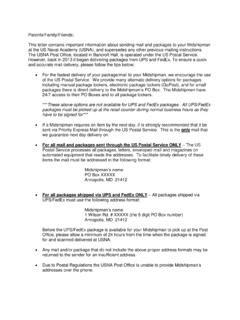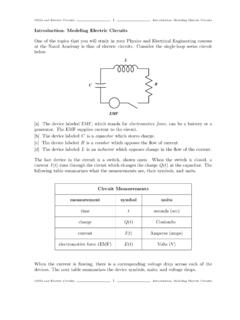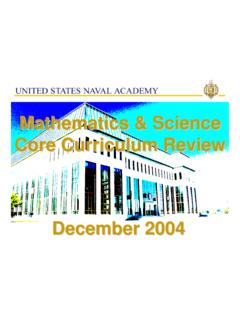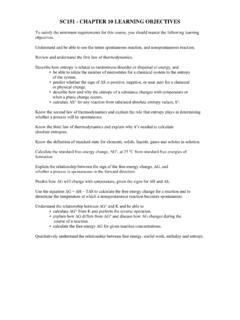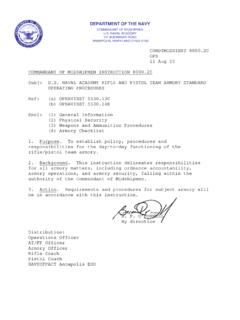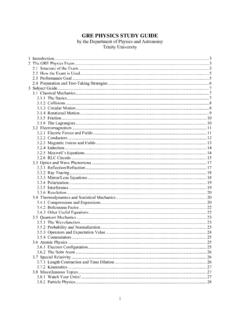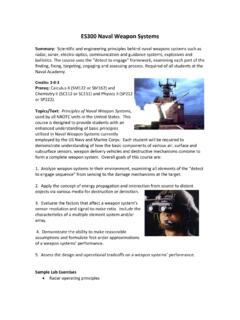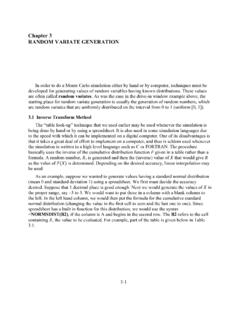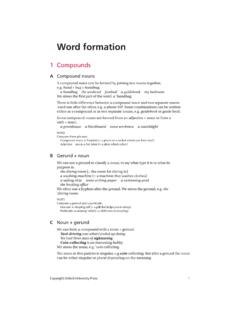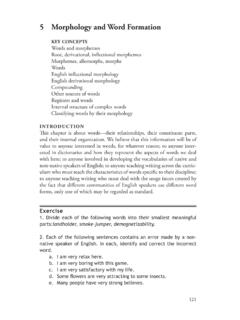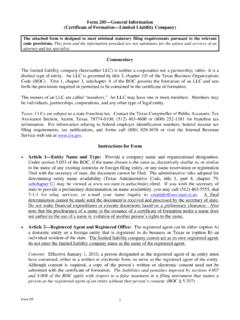Transcription of Exp12F Mg Rxn Hess Law 1010 - United States Naval Academy
1 E12F-1 Experiment 12F FV 10/1/10 CALORIMETRY AND HESS S LAW: FINDING H FOR THE COMBUSTION OF MAGNESIUM MATERIALS: 12 oz. Styrofoam cup with lid, thermometer, 50-mL and 100-mL graduated cylinders, weighing boat, M HCl, M NaOH, magnesium ribbon, magnesium oxide, copper wire. PURPOSE: The purpose of this experiment is to determine the enthalpy change for the combustion of magnesium: Mg (s) + O2 (g) MgO (s) Hrxn = Hcomb by determining the H values for reactions which can be combined together according to Hess Law, yielding the H for the desired reaction. LEARNING OBJECTIVES: By the end of this experiment, the student should be able to demonstrate the following proficiencies: 1. Construct and use a calorimeter. 2. Determine the heat capacity of a calorimeter using a reaction with known H. 3. Calculate the enthalpy change of a reaction from calorimetry data. 4.
2 Apply Hess s Law to calculate the enthalpy change associated with a reaction. 5. Use a spreadsheet program for data manipulation, graphing, and regression analysis. DISCUSSION: Elemental magnesium is one of the principal components of flares used to illuminate nighttime activities, or to aid in signaling one s location to aircraft and ships. Your instructor may ignite a strip of magnesium ribbon to demonstrate the combustion of magnesium in air. It will be evident that a great deal of light energy is released from this reaction. A direct method for measuring the heat produced by this reaction would be difficult, so we shall resort to an indirect method in this experiment as discussed below. Some chemical reactions (including the one above) are associated with the evolution of thermal energy and are called exothermic reactions. When there is absorption of energy in a chemical reaction, the process is called endothermic.
3 The magnitude of the energy change is determined by the particular reaction as well as the amount of product(s) formed. The thermal energy transferred in a balanced chemical reaction carried out at constant pressure is called the enthalpy of reaction (or heat of reaction) and is given the symbol Hrxn. Hrxn is often expressed in units of kJ/mole where mole refers to the amount of a reactant or a product involved in the reaction. In general, the reactant or product must be specified. In this experiment, you will measure the enthalpy changes of several exothermic reactions utilizing a simple calorimeter. This calorimeter consists of an insulated vessel (a Styrofoam cup), a thermometer, and a lid (which is loose fitting to allow the pressure to remain constant. The energy given off by any reaction carried out in the calorimeter is absorbed by both the calorimeter and the solvent (water). This causes an increase in the temperature of the calorimeter and solvent that can be measured by a thermometer.)
4 The heat that is absorbed by the calorimeter and solvent is calculated from the equation: qcal = C T (1) where C is the heat capacity of the calorimeter and solvent, and T is the change in temperature of the water (the solvent) in the calorimeter. Heat capacity is defined as the amount of energy required to raise the temperature of an object by 1 C. In this experiment, the vessel and the amount of solvent remain constant, so C is a constant. Enthalpy is an extensive quantity, so the amount of heat generated by the reaction is given by the expression: qrxn = n H (2) where n is the number of moles of a specific reactant or product and H is the enthalpy change of the reaction in kJ/mol. Since the energy of the universe is conserved, the total E12F-2 energy change of the system (the reaction) and surroundings (calorimeter and solvent) is equal to zero. These relationships can be combined as shown in equation (3).
5 Qsystem + qsurroundings = qreaction + qcalorimeter = n H + C T = 0 (3) This equation can be rearranged to determine either C or H as shown in equations (4) and (5). C = n H/ T (4) H = C T/n (5) For exothermic reactions, H < 0 and T > 0. The main experimental problem in any calorimetric measurement is obtaining an accurate value of T. The initial temperature, Ti, of the reactants can be determined directly using a thermometer. However, it is difficult to obtain a precise value for the final temperature, Tf (the instantaneous temperature when the reactants are mixed together and react), because (1) reactions do not occur instantaneously, and (2) calorimeters are not perfectly insulating, but actually allow some heat energy to slowly enter or escape from the calorimeter over time. This occurs both during the reaction and after its completion. Figure 1 illustrates the situation, and suggests a solution.
6 If an exothermic reaction occurs in a hypothetical calorimeter that is perfectly insulated, all of the heat produced by the reaction will remain in the calorimeter, resulting in a constant final temperature. This would yield the same T whether or not the reaction is instantaneous. Now consider a hypothetical exothermic reaction that occurs instantaneously, but in a realistic calorimeter that is not perfectly insulated. In this case, the temperature of the calorimeter would diminish over time due to the gradual escape of heat energy to the surroundings. The final temperature to be used in determining T in this case is actually the maximum temperature reached immediately after reaction occurs, since this temperature change is due exclusively to the heat produced in the reaction, and no escaping of heat to the surroundings has occurred yet. For real calorimeter experiments, reactions neither occur instantaneously nor are calorimeters perfectly insulated.
7 Thus, during an exothermic reaction the temperature of the calorimeter increases initially, but never has a chance to reach the correct maximum final temperature since heat is escaping to the surroundings even while the reaction is proceeding toward completion. A correction for this heat exchange is made by an extrapolation process using the temperature vs. time curve (see Figure 1). First, a plot of the temperature readings as a function of time for the reaction is generated. By extrapolating only the linear portion of the curve ( , the points including and after the maximum temperature) back to zero time (the time when the reactants were mixed in the calorimeter), Tf is obtained. The Tf value determined in this manner will be the temperature that the calorimeter and the solvent would have reached, had the reaction occurred instantaneously and with no heat exchange to the room. This value should be used for the calculation of change in temperature, T.
8 Consult Appendix O for specific instructions for extrapolation using Microsoft Excel. A. Determination of the Heat Capacity of the Calorimeter and Solvent Before measuring the enthalpy change of an unknown reaction, it is necessary to first determine the heat capacity of the calorimeter being used. This is done by measuring the temperature change, T, that occurs when a known reaction is carried out in the calorimeter. For this experiment, the reaction: HCl (aq) + NaOH (aq) H2O (l) + NaCl (aq) H = kJ/mol is performed to provide this calibration. Knowing the value of H for this reaction and the number of moles (n) of product formed, the heat capacity (C) can be calculated using equation (4). With the value of C known, the calorimeter 20222426283001 234 56 Tim e (m in)Temp (oC)TiNon-instantaneous reaction, perfectly insulated calorimeterTfInstantaneous reaction, perfectly insulated calorimeterInstantaneous reaction, partially insulated calorimeterFigure 1 E12F-3 can be used to determine the H for other reactions by carrying out the reaction in the same calorimeter, measuring T and using equation (5).
9 B. Determination of the Enthalpy of Combustion of Mg Using Hess s Law The calibrated calorimeter will be used to determine the enthalpy of combustion of magnesium by application of Hess s law. Consider the following reactions: (a) H2 (g) + O2 (g) H2O (l) Ha = kJ/mole (b) Mg (s) + 2 H+ (aq) Mg2+ (aq) + H2 (g) Hb (c) Mg2+ (aq) + H2O (l) MgO (s) + 2 H+ (aq) Hc By adding equations (a), (b), and (c) we obtain (d) Mg (s) + O2 (g) MgO (s) Hrxn = Ha + Hb + Hc which represents the combustion of Mg(s). Reaction (a) represents the formation of liquid water from its constituent elements. The enthalpy change for this reaction, symbolized Ha above, is the standard heat of formation of liquid water (or Hfo (H2O)) and is a known quantity. Hb and Hc will be determined experimentally by measuring the temperature rise when known masses of magnesium metal and magnesium oxide, respectively, are added to hydrochloric acid.
10 Reaction (c) as written is an endothermic reaction. Since it is easier to perform the reverse (exothermic) reaction, the data you collect will be of opposite sign to that needed for the Hess s law calculation for reaction (d). When data from your analysis is correctly combined with that for the known reaction (a), the enthalpy of combustion of magnesium metal can be obtained. E12F-4 PROCEDURE: Note: Handle the Styrofoam cups gently. They will be used by other lab sections! If your instructor demonstrates the combustion of magnesium reaction, do NOT look directly at the burning Mg. A. Determination of the Heat Capacity of the Calorimeter 1. Ensure that the Styrofoam cup is clean and dry inside, and that it has a properly fitting cap. 2. Rinse the 50-mL graduated cylinder with water and then rinse with a small amount of M NaOH (coat the sides by turning the graduated cylinder). Discard the rinses.
